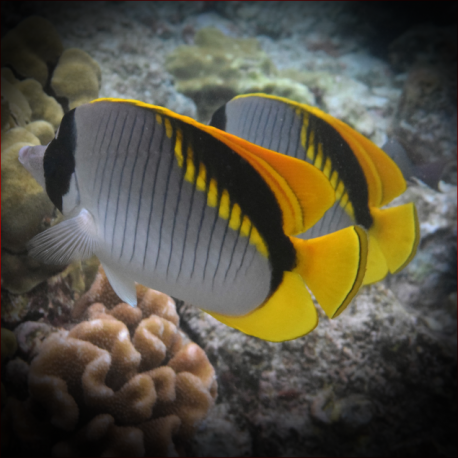More info
Datasheet
| Minimum Tank Size | 700 litres / 184.92 US gallons |
| Maximum Size | 30.0cm / 11.81inches |
| Reef Compatible | Not reef safe |
| Temperament | Might be aggressive towards other species |
| Temperature | 22.2°C / 71.96°F - 25.6°C / 78.08°F |
| Specific Gravity | 1.020-1.025 |
| Carbonate Hardness | 8-12 |
| pH | 8.1-8.4 |
General Description
The Lined Butterflyfish (Chaetodon lineolatus), also known as the Spot-nape Butterflyfish or New-moon Coralfish, belongs to the Chaetodontidae family. These fish are recognized for their colorful and striking patterns, closely related to Angelfish but lacking the spines on each side of the head typical in Angelfish. They are part of a complex of species within the Chaetodon genus, sometimes varying greatly in their dietary and habitat requirements.
Aquarium Suitability
Considered suitable for aquariums with care, the Lined Butterflyfish can be challenging to maintain due to its specialized feeding habits. These fish have a particular liking for coral polyps, which can make acclimatization in captivity difficult. To ensure their well-being, it is crucial to have various suitable food types ready and consider keeping live corals, mussels, and zooplankton to sustain them during the transition.
Demands, Care, and Hardiness
With an average hardiness level, these fish require a well-established aquarium with ample hiding spaces, especially when introduced as juveniles. They thrive in a spacious tank of at least 700 liters with plenty of room for swimming. Lined Butterflyfish feed best when provided a varied diet consisting of larger crustaceans, macroalgae, microalgae, and zooplankton. Regular feeding several times a day is essential for their optimal health.
Reef Suitability
However, the Lined Butterflyfish is not reef-safe due to its tendency to nibble at clams and eat tubeworms, posing a threat to certain reef inhabitants like anemones. It is recommended to keep them in fish-only aquariums to prevent any harm to coral species.
Aquarium Setup
When setting up the aquarium for Lined Butterflyfish, it is crucial to include live rocks and stones with sufficient algae for grazing. If natural algae are scarce, supplement their diet with algae-rich foods like Spirulina. Due to their territorial behavior and aggression towards other species, it is best to house them individually unless forming a bonded pair.
Behaviour
Known for their peaceful demeanor towards other fish species, Lined Butterflyfish tend to focus on their dietary preferences rather than displaying aggressive behavior. However, attention should be paid when introducing similar species to the tank, unless they are a mated pair.
Feeding and Diet
Their diet primarily consists of coral polyps, making feeding in captivity a potential challenge. Offering a varied diet of live SPS or LPS corals, along with frozen foods like shrimp, crabs, and invertebrates, can aid in meeting their nutritional requirements.
Habitat and Distribution
Lined Butterflyfish are native to the Indo-Pacific region, ranging from the Red Sea and East Africa to the Hawaiian Islands. They are commonly found in reefs and tropical coastal waters, displaying preferences for soft corals, anemones, tubeworms, and bristleworms as part of their natural diet.

